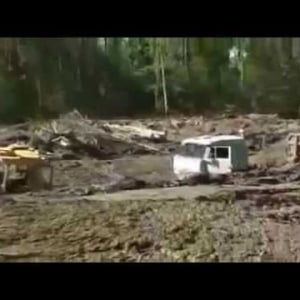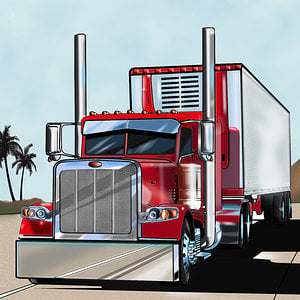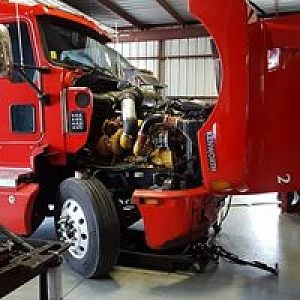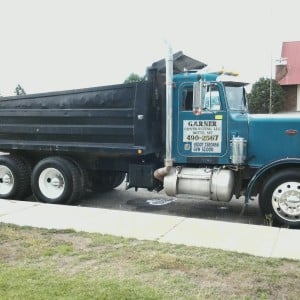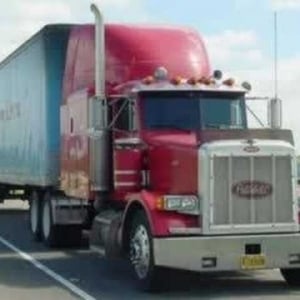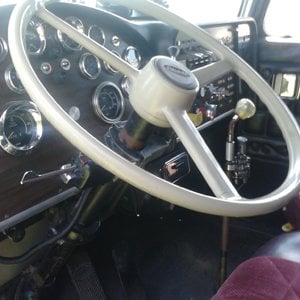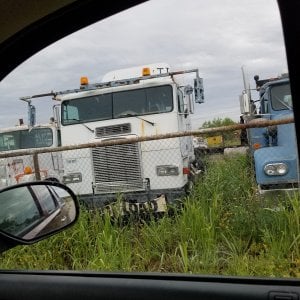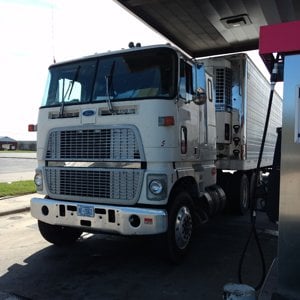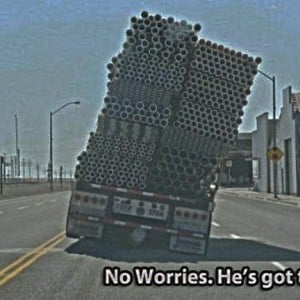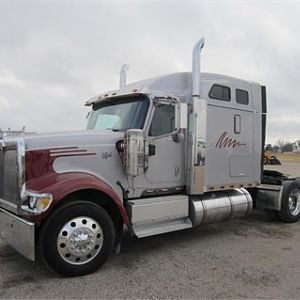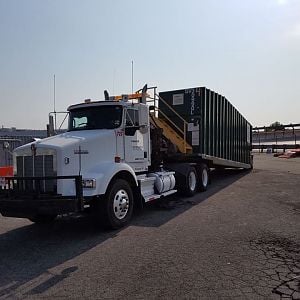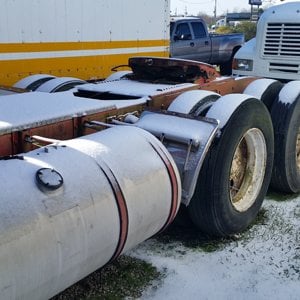Before you go.
So, you want to drive a big truck, this is what it’s like before you even hit the road.
I feel good today, it always helps. I’m going 3 hours away to switch trailers and come back, easy day.
After I get the bills and the keys, I am ready.
Today I drive a Volvo, one of my favorites.
As I walk towards the truck, I reflect on what I am doing. The fun of driving a large truck, the responsibility of travelling at 100kph (62mph) with something that weighs around 80,000 pounds or 40 tons.
As I get closer, I need to concentrate on my inspection of such a beast.
Is it the right truck, any leaks underneath and what is the first glance at the general condition.
Not being very tall, the door handle is at eye level. I unlock it and climb up, the seat is adjustable front to back, up and down and the seat back reclines, one can also adjust the pressure in the air bag under the seat so you can adjust the comfort level.
Once seated, I need to check the paperwork to make sure the truck is legal to go. Registration, yearly inspection report, cvor and any other papers depending on where and what I am carrying. All the paperwork is in order, so on to the next steps.
I need to open the hood, a latch inside under the steering column does the trick.
As I step out, the three point hold is best done while going backwards and stepping to the ground. The hood can be opened by pulling on the handle at the front edge or like me, pushing up one corner as I don’t have enough weight to pull the hood open.
On the left side, I check the oil level of the engine and the power steering fluid level, then a look at pretty much everything one can see, hoses, oil leaks, oil filler cap, loose wiring, radiator hoses, radiator condition, a look at the cooling fluid reservoir tells me it is full. BTW, the wire coming out of the reservoir is the engine shut down sensor if the cooling fluid level is too low A wiggle of the steering shaft will tell me if there is any loose in the Ujoints, steering box, free play, ball joints and tie rod ends. A look at the suspension for any broken parts, leaf, shackles and the like. If drum brake, check the adjustment and the inside condition of the tire, the thread and the outside of said tire, make sure all the wheel nuts are tight and that there is no oil leak at the seal. At the same time look to see if there are any cracks on the rim.
As you go around the front, make sure the convex mirrors, if any, are well attached. The other side is pretty much a repeat of the other one except for a few things, give a tug on the radiator shroud, to see if it is solid and that the radiator is not loose, a tug on the fan blade insures that the bearing is good and the clutch is functioning. A pull of the fan belt makes us look at its condition and the condition of the belt binder. Make sure the turbo pipes are in good condition as well as the exhaust pipes. Again make sure there are no loose parts or leakage. The windshield washer tank is there too, so make sure it is full.
Going to the rear of the truck, you check the right side mirror, windows, exhaust pipes and fairing. Open the fuel tank to check the level of fuel, touch the air dryer in case it is loose. At the rear, the air pressure in the tires can be checked by a gauge or hammer, if you use your foot like many of us do, try to avoid using the toe of your boots, give a good shove with your heel, that way, if there is any difference in pressure, it will be easier to feel. Tires are next, condition, wear, make sure that side by side tires have the same wear, otherwise the better tire will work harder and could fail. Rim condition, wheel nut tightness, oil leak, bubbles in a tire and debris caught between two tires are things to look out for. A look at brakes adjustments, lights, drive shafts, U-bots, suspension air bags. Be on the lookout for anything out of place or broken.
The fifth wheel is what holds your trailer in place. Are the bolts holding it in place all there and tight? Are the jaws lubricated and free? The placement of the fifth wheel is important as it can be adjusted to give more or less traction at the front tires, it can also be used to balance your load.
Next the air hoses and electrical wire, check for cracks and make su re the seals on the glad hands are in good condition, this prevents air leaks later on. Open the fuel tank on that side for the same reason.
As you climb back up to the cab, go over what you just did in your mind to make sure you did not forget any thing.
Before you start the engine, make sure you are in neutral and that you depress the clutch pedal, not to the floor, but about one or two inches off the floor, otherwise you put a lot of wear on the clutch brake as you crank over the engine.
When you turn the key, listen for any abnormal sounds and keep an eye on the oil pressure gauge, it should register pressure within a few seconds of engine start.
You feel the clash of the bendix gear against the ring gear and the first firing of a cylinder, then as the engine settles down to a smooth idle, feel for any misfiring or any noise out of the ordinary. A look across the dash at the instruments tells you, oil pressure and alternator condition, a buzzer type of sound will indicate low air pressure which you monitor that it goes up at a proper rate.
Back outside, make sure there are no leaks at the engine, exhaust, radiator, turbo, power steering or oil. As you close the hood check the lights, a little pass with the rag will clean them. A go around again by the back gives you reassurance that all is good and your set to go. Three more things inside the cab are mandatory and must be inspected, first aid kit, fire extinguisher and reflective triangles ( flares don’t last long and should not be used if carrying dangerous goods).
Inside, you do the air system check, buzzer pressure cutoff, rate of pressure buildup and leakage test. You can now adjust the seat, seat back, mirrors and the steering wheel for your best confort. Your left foot tells you where the friction point of the clutch is and if the linkage is in good condition.
Another quick look around the dash and outside, you are ready to go. Being bobtail (no trailer), 3rd gear would be the one of choice, clutch all the way down just long enough to stop the gears in the tranny and then you present gently the shifter in the hole, if it does not go in easily, release clutch to the friction point to turn the gears a little then it will go in with the smallest pressure. With the clutch only, no fuel, advance a couple of feet then disengage the clutch to see if there is any resistance indicating a brake that has not released completely, if there is none, you go.
Remember, an engine will warm up better under a light load, so it is better to move as soon as you are ready, then everything warms up at the same time.
Shifting gears properly is an art that can only be learned with experience and knowledge of what is happening in the transmission. This will be discussed in another article.
Once you find the trailer for your trip, look it over, is it leaning? is the front at the right height? is it accessible easily and how does it look? Make sure you are square with the trailer as you get to it by backing up slowly, if you have a day cab you can see where the fifth wheel is in relation to the trailer, you should have the suspension squat a little when you go under the trailer, it assure you the fifth wheel will not go under the pin, Avoid hitting the pin with to much much force, it is strong but damage to it or the fifth wheel can happen, but a firm clunk is need to make sure the jaws close properly around the pin. A slight pull forward will tell you if you are hooked. Apply brakes to the tractor for safety, turn on the 4 way flashers then go out and inspect the trailer.
Start with the paperwork, registration and certificate of inspection, then connect the air lines and the electrical cable. Lift the dolly legs then go under with a flashlight to look at the jaws of the fifth wheel to ensure they are well closed. Then look for any damaged or weak cross members as you go towards the back, make sure all the lights, top and bottom are working, are the air hoses secure and not dragging on the ground. Check that the pins for the adjustable dolly are well in place, tires, rims, mud flaps and wheel nuts get the same inspection as with the tractor. At the rear now, check the lights including the license plate light, examine the door(s) for condition, if sealed check the number against the bills, if not, open the door. Depending if empty or loaded, you check if load is downgraded or attached according to load securememt rules. Make sure door is properly closed then proceed to the other side and continue with inspection as per said before.
Note all damage or defaults in the inspection book, if major defect, report and send truck to garage, it cannot be driven, if minor report and have repair done right away or at least at the time of return.
If you are not sure if a defect is major or minor, you usually have a list on the cover of the inspection book. Use that as a reference.
Ready to go, not quite yet. Apply the trailer brake manually and put the turn indicators on one side. Go out and check for any audible air leaks and to see if the turn indicator is flashing on the right side, the wires can be crossed between the truck and trailer. One last look and back to the cab. While you put on your seat belt, you have a look at the gauges just to make sure all is good. As you look around for traffic, release the brakes and put the transmission in gear. Move ahead a few feet and apply trailer brakes to ensure they work.
As said before, the operation of the transmission is the subject of another article, so, I will skip this.
Fill in your log book as per the HOS (hours of service) regulations.
Now you are ready for the road, so get ready, this is unlike anything else.
The sheer size and weight of the truck can be intimidating, as it should be. Depending on the configuration and number of axles, the truck can weight up to 130,000 pounds. The notions of acceleration, cornering or braking take a whole different meaning. Acceleration is a slow process of gathering speed, cornering has to be done carefully as your load could make you tip over, braking is something that takes planning as stopping 60 tons from highway speeds cannot be done on a dime. Obviously, the proper mindset is needed, safety first, then scheduling.
Back to the drive, as you start moving around the yard, be on the lookout for any anomalies with your truck, wheels turning, engine working well, response to the driver input from all the controls, etc,. Usually, you will have enough room in the yard to move around easily, once you make the turn onto the road, a quick look back helps you to determine the turning space of your particular setup. The five principle of using your eyes become very important here, look far so you can plan ahead with the traffic, look wide so you can see what is coming from the sides and the rear, keep your eyes moving around, remember, you will steer towards whatever you are staring at, so, no fixating, leave yourself an out, do not get put in a box where you have no choice of what to do, keep a way out, make sure you are seen, eye contact with other driver is the key to being seen during the day but at night it is more difficult, use extra caution then.
The actual driving is not hard, power steering, air brakes, clutch, shifter all take a light hand.
There you have it, going down the road will be the subject of another article.

